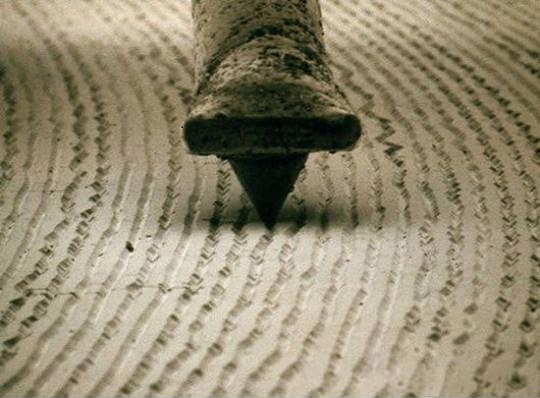Question: Is it normal to hear soft music coming directly from the surface of a record, even if the record is not playing through speakers?
Answer: Yes, this is normal. It is commonly referred to as “surface noise” or “needle chatter,” though there is no universally accepted term for the phenomenon. “Surface noise” is also used to refer to the pops and clicks that are sometimes heard while playing a record, but that is not what we’re talking about here. For our purposes, “surface noise” means sound of the recording that is heard directly from the surface of the record as the record is being played. Let’s look into why this occurs.

First, remember that the record and turntable concepts go back to the turn of the 20th century. And recall that sound is just a series of vibrations. Old Victrola players, for example, used a needle (aka stylus) that ran through the grooves of a moving record, creating audible sound as the stylus vibrated within the record grooves. Sound recordings were originally made using the same concept. Sounds (vibrations) moved a needle (aka cutting stylus) on a record, causing cuts or grooves in the record surface. When played back, a needle moved through the cut grooves, causing vibrations that resulted in noise approximating the original sound. This is a very simplified explanation of a pretty sophisticated process.
The noise that is heard from the surface of a record is the vibration from the stylus riding in the record groove. Originally, this sound was captured by funneling the sound into a hollow tube that contained a flexible diaphragm and that fed into a flared horn. Victrola players allowed sound to be naturally amplified through this diaphragm and horn. We see this same concept used today in modern turntables. Modern turntables take those same vibrations from the stylus, but use them to create an electrical signal. This signal is then amplified and “corrected” according to the RIAA equalization curve before being output from the turntable. Next, the sound is amplified again with a power amplifier and sent out to the speakers. The speakers vibrate in relation to the amplified audio signal. This vibration causes sound, which is picked up by the human ear. But if you listen closely, you can still hear the vibration sounds coming from the record surface itself. As we indicated earlier, this surface noise is perfectly normal.
Hopefully this brief look into turntable development and operation not only helped explain surface noise but also gave you a better appreciation for the technical expertise that goes into creating each Audio-Technica turntable. If you have any further questions, feel free to contact the Audio Solutions Department.
















































































































































.webp)































